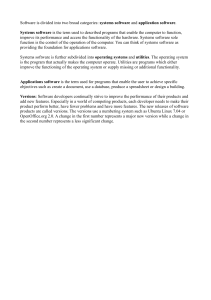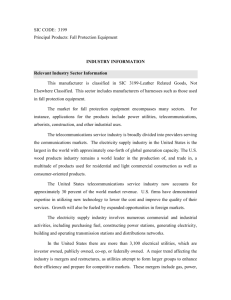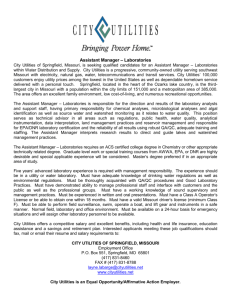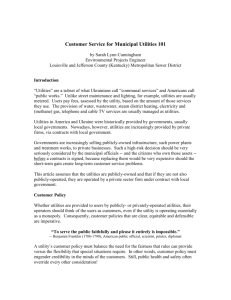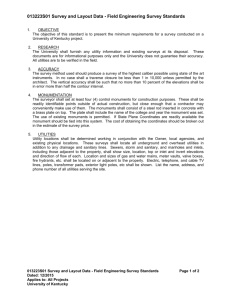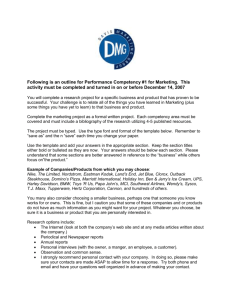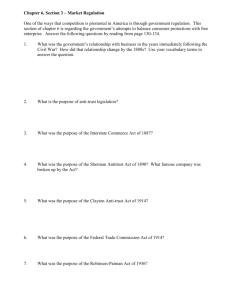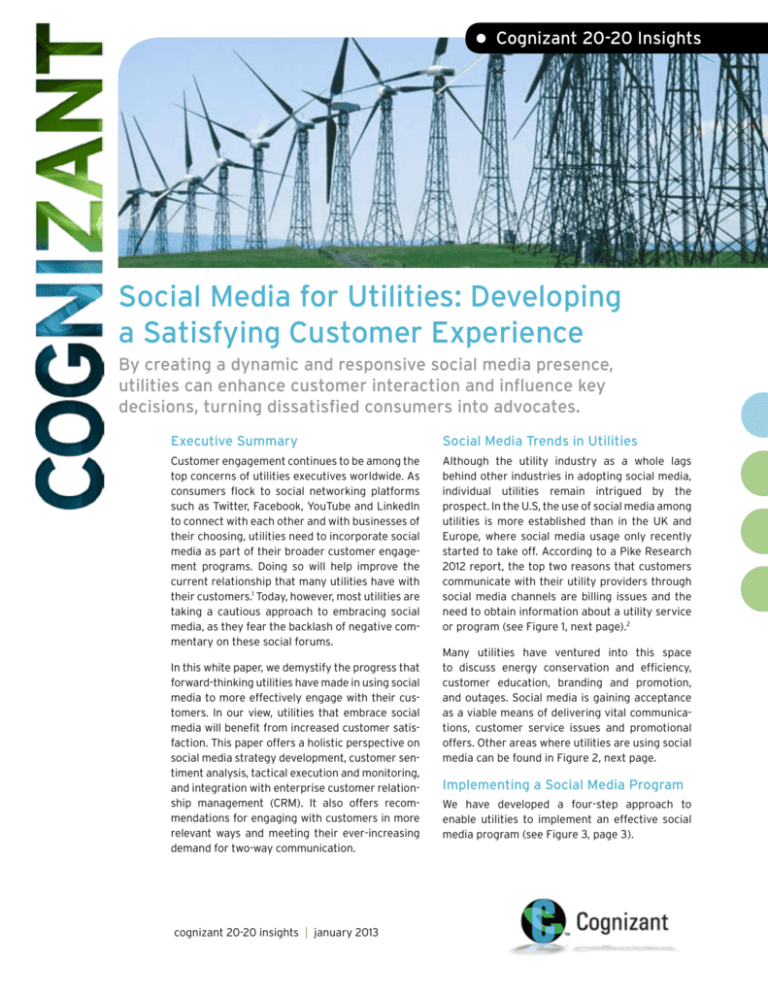
• Cognizant 20-20 Insights
Social Media for Utilities: Developing
a Satisfying Customer Experience
By creating a dynamic and responsive social media presence,
utilities can enhance customer interaction and influence key
decisions, turning dissatisfied consumers into advocates.
Executive Summary
Social Media Trends in Utilities
Customer engagement continues to be among the
top concerns of utilities executives worldwide. As
consumers flock to social networking platforms
such as Twitter, Facebook, YouTube and LinkedIn
to connect with each other and with businesses of
their choosing, utilities need to incorporate social
media as part of their broader customer engagement programs. Doing so will help improve the
current relationship that many utilities have with
their customers.1 Today, however, most utilities are
taking a cautious approach to embracing social
media, as they fear the backlash of negative commentary on these social forums.
Although the utility industry as a whole lags
behind other industries in adopting social media,
individual utilities remain intrigued by the
prospect. In the U.S, the use of social media among
utilities is more established than in the UK and
Europe, where social media usage only recently
started to take off. According to a Pike Research
2012 report, the top two reasons that customers
communicate with their utility providers through
social media channels are billing issues and the
need to obtain information about a utility service
or program (see Figure 1, next page).2
In this white paper, we demystify the progress that
forward-thinking utilities have made in using social
media to more effectively engage with their customers. In our view, utilities that embrace social
media will benefit from increased customer satisfaction. This paper offers a holistic perspective on
social media strategy development, customer sentiment analysis, tactical execution and monitoring,
and integration with enterprise customer relationship management (CRM). It also offers recommendations for engaging with customers in more
relevant ways and meeting their ever-increasing
demand for two-way communication.
cognizant 20-20 insights | january 2013
Many utilities have ventured into this space
to discuss energy conservation and efficiency,
customer education, branding and promotion,
and outages. Social media is gaining acceptance
as a viable means of delivering vital communications, customer service issues and promotional
offers. Other areas where utilities are using social
media can be found in Figure 2, next page.
Implementing a Social Media Program
We have developed a four-step approach to
enable utilities to implement an effective social
media program (see Figure 3, page 3).
Social Media’s Emerging Consumer Imperatives
Billing issue
Obtain information about
utility service or programs
Praise about service
31.5%
31.5%
24.7%
Service outage
19.2%
Service issue other than outage
16.4%
Schedule a new service installation
15.1%
Complain about service
11.5%
Other
6.8%
0
5
10
15
20
25
30
35
(Percent of respondents)
Base: 73 U.S. consumers
Source: “Social Media in the Utility Industry Consumer Survey,” Pike Research, Q1, 2012.
Figure 1
Step 1: Think Beyond the Meter
Utilities need to look beyond the meter at the
customer premises and create an interactive
communication channel through the use of social
media. Via social channels, utilities can begin to
reconnect with customers by replying to issues
and responding to negative comments. The connecting power of social media can act as a com-
plement to, not a replacement for, more traditional channels, such as customer care, e-mail, online
forums, interactive voice response systems, etc.
Social media connections can be driven through
the following approaches:
• Initiate conversations: Utilities should initiate
a two-way channel, with which they interact
Utilities’ Social Media Priorities
Crisis
Communication
Description: Outage management and storm information is communicated in real
time, such as on Twitter.
Examples: Dominion Virginia Power, Public Service of New Hampshire, Pepco
Customer
Education
Description: Educate customers through YouTube and Facebook on topics such as
recycling, renewable energy, energy efficiency, etc.
Examples: Florida Power & Light, Xcel Energy, Nebraska Public Power District
Customer
Service
Description: Launch a social media Web site to serve customers through Facebook,
Twitter, YouTube, blogs, etc.
Examples: Reliant Energy, Centrica, Kentucky Public Service Commission
Energy
Efficiency
Description: Use of social media to engender energy saving behavior and educate
on climate change issues and energy efficiency methods.
Examples: Apps like Social Energy App, JouleBug, Facebook App
Demand
Response
Description: Platform for realizing the goal of demand response programs, which
encourage and incentivize customers to reduce demand during peak periods .
Examples: Opower developed a Facebook app promoting an energy-saving competition among friends.
Green Energy
Promotion
Branding
Recruitment
Description: Market-renewable energy service options, tapping the younger
generation for green energy and carbon offset programs.
Examples: Duke Energy, Public Service of New Hampshire
Description: Platforms to monitor utilities’ brand value and for marketing-related
activities.
Examples: Nebraska Public Power District has created a Facebook page to use for
branding purposes.
Description: Use of LinkedIn to advertise positions and recruit employees.
Examples: Southern California Edison, Xcel Energy, Progress Energy
Source: Various industry reports 3
Figure 2
cognizant 20-20 insights
2
Four-Step Plan
create a “word-of-mouth” following. To enable
this, utilities need to enlist their employees
and influencers to help create and distribute
key messages. Tools that allow amplification
include:
1
Think
Beyond
the Meter
4
Integrate
Social Media
with CRM
Approach to
Implement
Social Media
Program
>> GaggleAMP, a platform that allows companies to amplify their social messaging by
leveraging employees, customers and partners.
2
Tap Social
Media
Analytics
>> SocialToaster, which helps recruit support-
ers to automatically create word-of-mouth
referrals and traffic through Facebook,
LinkedIn and Twitter.
3
>> Spread.us, a Twitter-only tool that allows
Transform
Customer
Engagement
Figure 3
not only with meters but also directly with
customers. New programs and features can
be easily communicated informally among
customers, with the help of functions such as
the “like” feature on Facebook. Twitter can
be used as a communications medium with
customers during outages and other crises,
such as conveying storm information.
• Drive
conversations: One of the most
important aspects of blogging is to build
a community in which utilities experts can
answer customer questions. Utilities experts
can provide advice and information on smart
meter advantages and capabilities, electric
vehicle charging tips, reducing energy consumption, insulation, energy efficiency, power
reliability, outage reduction information, etc. A
rapid response can turn disgruntled customers
into ambassadors for the utility. Moreover,
because these interactions occur on social
media, it’s open for the public to see, which can
enhance the company’s reputation for transparency and responsiveness.
• Spread
conversations: Utilities can create a
social mashup, a simple Web-based application
that combines content and functionality from
a variety of sources through highly compatible
and simply installed Web plug-ins. This
approach ensures a continuous information
feed that alerts customers to tips for reducing
energy consumption, using smart appliances,
restoring power and other related information.
• Amplify conversations: Social media enables
companies to re-distribute messages and
cognizant 20-20 insights
individuals to promote campaigns and blog
posts.4
A simple analysis of the strengths, weaknesses,
opportunities and threats (SWOT) will help utilities understand the importance of analyzing
social media (see Figure 4, next page). Utilities
should perform a detailed SWOT analysis based
on their particular business strategy and priorities.
Step 2: Tap Social Media Analytics, Monitor
Customer Sentiments
Utilities can act on the derived intelligence
obtained from the multiplying pools of unstructured social media data to improve business
results, increase brand awareness and polish their
reputations. They can achieve these goals by
responding to and managing crises and outages,
communicating energy efficiency programs and
engaging in initiatives such as online cross-selling and marketing, customer satisfaction and
advocacy. Utilities can also use sophisticated analytics tools to harness the power of social data,
although such tools are in the early stages.
Making Sense of the Noise
For utilities adopting a social media analytics
strategy, it is imperative to evaluate the maturity
of social media usage across different business
units within the organization. This requires a consultative approach, with a detailed assessment
of present-state social media adoption maturity,
capabilities for adopting new technologies, a
perspective on implementation feasibility and a
close assessment of budgetary constraints. The
real value of social media can be derived from
integrating real-time insights from unstructured
data with enterprise business intelligence and
customer relationship management platforms to
advance proactive decision-making.
3
Internal
Sample SWOT Analysis
Favorable
Unfavorable
Strengths
Weakness
• Huge source of freely available information.
• Proactive engagement with customers; faster
• New mode of communication.
• Requires urgent effort to mitigate negative
•
•
•
•
resolution of issues and queries.
Real-time communication updates on energy
efficiency, product launches, crisis management.
Improved relationship between utilities and
customers.
• Strengthened reputation for transparency and
• Need to align social media strategy with legal
• Ability to listen and respond proactively ahead of
• Risk of damaged brand image due to high
• Ability to measure customer pulse informally and
• Risks associated with security, privacy and
and regulatory compliance.
customer-friendliness.
exposure.
customer trends.
External
image and mistakes.
Return-on-investment is difficult to recognize.
Requires a dedicated team to look into
customer grievances. ethics.
analyze customer sentiments.
• Increased online cross-selling opportunities.
• Easier exploration into new markets, such as
Internet-savvy customer segments.
Opportunities
Threats
Source: Cognizant
Figure 4
Utilities can derive value from the large amount
of unstructured, free-form text driven by the conversations and sentiments (positive, negative and
neutral) expressed across various social media
platforms. This will help them align their customer
engagement strategies by listening, monitoring
and acting in real-time to meet consumer requirements. Unstructured text includes comments
posted on social media platforms and other
blogging sites, customer care notes and customer
survey responses.
1. Identify and crawl social media sites and local
consumer forums to capture relevant posts
and filter out the non-relevant ones.
2.Listen and extract key information on products
and services, energy efficiency plans and new
services and symptoms, using algorithms,
clusters, filters and taxonomy.
3.Analyze and find relevance within business
contexts, relationships with company programs
and issues using different analytical models
and sentiment analysis.
Framework Development for Data Analysis
We have developed a social listening framework
to analyze and make sense of proliferating social
chatter. Using this framework, utilities can collect,
process and analyze data, as well as deliver
actionable business insights. Social listening and
analysis is performed on the information gathered
from social media, particularly from public pages,
forums, blogs, news, review sites, microblogs or
any publicly available data from social channels.
The framework encompasses a five-step method
for generating social media data insights (see
Figure 5, next page):5
cognizant 20-20 insights
4.Act and report business attributes and metrics
on influence, sentiments, volume and demographics, etc. to derive actionable business
insights.
5.Integrate and monitor analyzed information
within the enterprise database for continuous
insight and customer sociability.
Social business analysts at the command center6
can then work closely with senior leaders within
the utility to determine the business scenario,
industry scope and specific business cases to
track, creating a “social pulse” for enterprise-
4
Social Listening Analysis Framework
Identify
• Scenario scope
and objectives
• Source categorization
> Social networks
> Blogs and microblogs
> Professional
networks
> Forums
• Source selection
criteria
• Analytical tools
Listen
Analyze
Act
• Keywords list
• Domain taxonomy
• Data crawling
• Analytical models
• Actionable insights
• Establishment of
• Basic analytics
• CRM integration
• Data supply chain
• Advanced analytics
and cleaning
• Filter data
and clusters
• Algorithms
• Data indexing
• Querying and
search engine
> Opinion mining
> Early warning
system
> Predictive modeling
> Network mining
• Churn analysis
• Unusual occurrence
monitoring
• Sentiment analysis
after aligning with
business
and metrics
• Periodic reporting
• Real-time
dashboard
• Visualization
Integrate
command center
and metrics
• Industry benchmarks
• Documentation
and infrastructure
Source: Cognizant
Figure 5
wide analysis. The utility’s command center can
use established processes to collect and analyze
social media data relevant to the overall organization. These processes can then be shared
with various business groups (sales, marketing,
customer service, etc.).
Social Media Analytics Dashboard
To become a socially-engaged organization, utilities need to understand and gain insights from
social media through metrics, measurements,
sentiment analysis and analytics reporting. A
social media analytics dashboard will inform
senior management on progress, strengths and
weaknesses and then identify ways to improve.
Linking social media analytics to organizationwide multi-channel analytics dashboards will
provide utilities with a complete arsenal of
business intelligence. Figure 6, next page, illustrates a sample list of metrics that utilities can
use to monitor their social media presence with
respect to their products and launches.7
Step 3: Transforming Customer Engagement
with the ’Utilities Connected App’
To increase the adoption of online customer selfservice, forward-thinking utilities are proactively
providing information about outages, work restoration times and emergency information on their
social media and Web sites or through a mobile
app. Doing so drastically reduces the volume of
customer phone calls and e-mails, thus allowing
cognizant 20-20 insights
utilities to maintain a lean customer care structure and reduce the overall cost to serve each
customer. Using social media apps, utilities can
not only share messages in an extremely quick
and cost-efficient manner, but they can also tailor
messages to targeted customers. This creates a
win-win situation for both utilities and consumers.
Creating Customer Impact via
Social Media Apps
Utilities can develop a social media app for environments such as Facebook to motivate more
customers to use online self-service channels,
acquire customers and solve issues related to
customer service. The app can enable two-way
communications between customers and the
utility, such as a bi-directional flow of customer
information from the consumer’s social media
page to the utility’s page and vice versa (see
Figure 7, page 7). Utilities can reap the following
benefits from such an app:
• Radically
improve customer engagement
through interactive “customer journeys,”8
such as submitting meter reads, obtaining
quotations, paying bills, sales, gathering
product and service knowledge, etc.
• Accelerate customer use of online channels
(e.g., word-of-mouth spread through the
Facebook “like” feature) to perform necessary
transactions, thereby increasing the online
penetration of the utility’s customer base.
5
Social Media Measurement Metrics
Utilities Social Analytics
Key
Performance
Indicators
(KPIs)
Basic Analytics
Share of voice (SOV) =
Billing
Awareness
Advanced Analytics
Number of billing-related
conversations
Total number of utilities
conversations
Sentiment analysis = positive (%), negative (%)
and neutral (%) Facebook
comments, Twitter mentions,
blogs, conversations.
Social reach = Total number of customers
across all social platforms
conversing on energy efficiency
(EE) programs
Energy
Efficiency
Number of likes + number
Program
of shares + number of blog
Effectiveness EE program launch =
comments
Share of voice (SOV) =
Sentiment indicator
Number of estimated billingrelated conversations
Total number of billing-related
mentions
(Positive conversations – negative conversations)
(Positive conversations + negative conversations)
Trend analysis: Customer pulse on billing exception
and meter reading accuracy trends.
EE program launch analysis:
• By campaign
• Per specific social platform (e.g. Twitter, Facebook)
• Per specific post
Social campaign
cost /benefit analysis =
ROI of traditional EE
marketing campaigns
Number of published posts
for utility company
Growth = month-over-month, quarter-over-quarter
Churn rate = number of customers changing
utilities
ROI of social media
campaigns
Social CRM and enterprise CRM integration:
• Integrate social media customer data with enterprise
ERP/CRM applications.
Customer
Satisfaction
• Proactive issue resolution: Mine customer social
Complaint visibility and feedback =
Ability of marketing department or customer
service executives to respond to issues raised
by customers in social channels.
posts to identify issues discussed and respond
appropriately.
• Continuous monitoring: Text and sentiment analysis
of social posts of customers.
Source: Cognizant
Figure 6
>> Build
• Provide
insights that enable customers to
compare their power usage with that of their
peers with similar living spaces and area zones
or to compare rebate programs and heating/air
conditioning services from different utilities, etc.
• Reduce dependency on traditional customer
service agents, thus lowering the service
center’s overhead costs.
• Cut
the cost-to-serve per customer in the
emerging digital age.
Basic features of a Facebook app include:
• Brand-building:
>> Use the social media app to “humanize” the
brand.
>> Respond to customer queries and be open
to feedback as a responsible and accountable utilities service provider.
cognizant 20-20 insights
a positive community of customers
through the “like” feature of Facebook.
>> Use Facebook apps to provide access to information from around the Web.
>> Create content tailored to customer needs.
• Online account management:
>> Account overview and summary.
>> Energy consumption graphs and analysis.
>> Communication channels (SMS messaging,
e-mail, Web chat, etc.).
>> Crisis event notification and alerts.
>> Proactive energy efficiency tips.
• Sales:
>> Get quotes for new customers or plan
change quotes.
6
Features of a Facebook App
Sales and
poning
Cou
Account
Management
nd Building
Bra
maturity and, most importantly, on the way it
manages customers. Integrating CRM and social
media data should be about converting conversations into transactions. It is about going beyond
Facebook, Twitter and other social
media channels and finding ways Integrating CRM
to enter into a boundaryless world,
and social media
where customers are in control of
9
data should be
the conversation.
• Analyze the conversation data: about converting
Listen to and understand conversations into
unstructured conversations from
transactions.
consumers.
B illi n g a n d
• Understand the social presence of customers: Gather information on customers’ social
media presence and create a social map of
their details within the CRM system and marketing database.
P ay m e nts
• Define the social media strategy: Define how
Figure 7
the social media strategy aligns with organizational goals and objectives through people,
processes and technologies.
>> Cross-selling opportunities for existing customers.
>> Product and tariff management.
>> Online promotional activities, such as loy-
• Operationalize
the social media plan:
Establish a social media roadmap based on the
requirements and processes. Utilities need to
consider these three levers:
alty programs, etc.
>> Share
interesting and customized posts
rather than generic sales offers.
>> People:
Culture, skills, training, planning
policies, governance, etc.
• Billing and payments:
>> Respond and solve billing issues.
>> View billing and other online statements.
>> Bill notification to customers.
>> Make payment feature.
>> Direct debit-enabling feature.
Step 4: Integrating Social Media with CRM
We live in a business world that is increasingly
focused on improving the customer experience.
One of the best ways to do this is to leverage
existing customer insights by integrating social
data with transactional and structured data contained within enterprise CRM systems.
Utilities can use social CRM to streamline and
improve customer communications. This will
create opportunities to address customer churn
and retain brand image in a competitive and deregulated market. Further, it will help them to streamline and improve customer communications.
>> Process: Organizational processes, such as
marketing, sales, customer service, knowledge management, human resources, customer data management, etc.
>> Technologies: Content management, integration, infrastructure, analytics, software,
specific use cases, etc.
• Prepare traditional CRM to be ready for social
media: Upgrade and modify the workflow,
processes, rules, data structure, training, call
center, people, etc. with existing CRM systems
to enable more effective integration with social
data.
• Manage organizational change management:
Create a social business change management
plan and involve customer-facing departments
like marketing, human resources, branding and
promotion, etc. to align common goals.
• Integrate with existing CRM systems: Finally,
integrate social data with the CRM database,
along with social analytics tools, to spot
negative comments and work with the business
to design quick-response capabilities to protect
brand reputation.
Steps to Integrate CRM and Social Media Data
The steps needed to integrate social media with
CRM data depend on the organization’s CRM
cognizant 20-20 insights
7
Risk and Mitigation Strategy
In this digital world, communications channels
have greatly changed, while the regulatory obligations of utilities across various geographies
have remained the same. Therefore, it’s necessary for companies to be accustomed to both the
opportunities for and the regulatory concerns
posed by social media.
Embracing social media poses risks for utilities;
however, companies should not avoid the inevitable. A risk mitigation strategy can alleviate
the impact of negative events and other risks,
based on internal organizational strengths (see
Figure 8).10
Socializing the Plan
Customers are choosing social media platforms to
interact with brands of choice and for assistance
on products and services. Given this social shift
in customer mind-set, it is imperative for utilities
to create a social media policy for employees,
senior management and contractors; continue to
track basic social media performance indicators;
monitor social conversations; and address issues
when they occur.
Utilities should implement a proactive social
media listening program and generate timely
reports for their marketing departments so they
can detect negative comments and engage with
them before they influence overall market sentiment. To do this, utilities need to design a synchronized event-response center to educate customers on relevant facts and information on their
various initiatives. At the enterprise level, this will
be achieved by integrating social media with CRM
strategies. Thus, utilities would be wise from the
get-go to create risk mitigation plans and utilize
social tools and techniques to portray a new,
transparent, innovative and customer-friendly
brand image.
Playing by the Rules
Known Risks
Risk Mitigation Strategy
Negative
Comments
A proper response protocol should be in place as part of the social media strategy.
Negative comments should be handled by the appropriate departments, such as marketing, branding, human resources, business solutions (smart meters, energy efficiency,
demand response, etc.). Proper monitoring mechanisms need to be in place to delete
offensive and inappropriate comments.
Privacy Risks
If proprietary or personal information needs to be shared (such as account details, billing
issues, etc.), utilities should encourage customers to interact offline with utilities or
customer care executives.
Data Security
Utilities should have proper software protections and firewalls in place to protect utilities’
social media sites, such as blogs, Facebook, Twitter, etc.
Updated
Information
Utilities’ marketing teams should examine information posted on social media sites (as
part of the social media strategy) to ensure that customers are provided with the latest
information.
Legal Risks
Utilities should abide by proper Web site crawling guidelines (such as robots.txt guidance)
and should not crawl and analyze personal customer information obtained via social
media platforms.
Fraud Risks
Utilities should provide adequate anti-fraud training to managers and employees to ensure
appropriate social media usage and to identify and respond to fraudulent activities.
Figure 8
cognizant 20-20 insights
8
Footnotes
1
“The Rise of Smart Customers,” Ernst & Young, 2011, http://www.ey.com/Publication/vwLUAssets/
Rise_of_smart_customers_-_What_the_sector_thinks/$FILE/The_rise_of_smart_customers_What_the_
sector_thinks.pdf. The survey shows 75% of respondents reported a negative relationship with their
energy supplier, and none rated the relationship as positive.
2
“Social Media in the Utility Industry: Consumer Survey,” Pike Research, 2012.
3
R.P. Siegel, “Top Utilities Reaching Out With Social Media,” TriplePundit, March 7, 2012,
http://www.triplepundit.com/2012/03/top-utilities-reaching-social-media/.
Matthew Burks, “Top Utilities Using Social Media,” Esource, July 10, 2012,
http://www.esource.com/Blog/ESource/7-10-12-SocialMedia.
Mike Breslin, “Social Media and Utilities,” Intelligent Utility Magazine, July/August 2009,
http://www.intelligentutility.com/magazine/article/social-media-and-utilities.
Christopher Perdue, “Utilities Facing Up to Social Media,” EnergyBiz, June 26, 2011,
http://www.energybiz.com/article/11/06/utilities-facing-social-media.
4
David A. Schweidel, Wendy W. Moe and Chris Boudreaux, “Social Media Intelligence: Measuring Brand
Sentiment from Online Conversations,” Robert H. Smith School of Business, University of Maryland, June
2012, http://www.rhsmith.umd.edu/faculty/wmoe/SMI%20(ART).pdf.
5
Dr. Freimut Bodendorf, “Social Media Analytics,” Institute of Information Systems, University of Erlangen-Nuremberg, January 2011,
http://www.iaria.org/conferences2011/filesDBKDA11/Globenet11_Keynote_FreimutBodendorf.pdf.
6
A command center is a monitoring and analysis center in which utilities can track the “social pulse” of
customers for enterprise-wide analysis. It uses standard frameworks and processes to collect and analyze
conversations, obtain competitive insights and extract customer sentiments. The resulting social media
analysis can be passed on to different business groups. The command center engagement model setup
can be accomplished through partnerships, joint ventures, managed services and other evolving business
models.
7
Marshall Sponder, “Tracking Social Media ROI Viewing Spectrum Analytics,” Webmetricsguru, Sept. 5,
2010, http://www.scribd.com/doc/38176762/Tracking-Social-Media-ROI-using-Spectrum-Analytics.
8
A customer journey is a map in the form of a diagram or writeup that illustrates the steps customers
undergo when engaging with utilities for products and services, including the online experience, sales,
new product launches or any other combination. It represents the different touchpoints that characterize
customer interaction with the service provided by the utility.
9
Chet Geschickter and Zarko Sumic, “Social Media Provides Utilities a New Channel for Customer
Engagement,” Gartner, Inc., March 19, 2012.
10 Carolyn Elefant, “The Power of Social Media: Legal Issues and Best Practices for Utilities Engaging Social
Media,” Energy Law Journal, Vol. 32, No. 1, 2011, http://www.docstoc.com/docs/84179818/The-Power-ofSocial-Media-Legal-Issues-and-Best-Practices-for-Utilities-Engaging-Social-Media.
cognizant 20-20 insights
9
About the Authors
Debasish Bera is a Senior Consultant within the Energy and Utilities Practice of Cognizant Business
Consulting. He has 10 years of energy and utilities industry experience in consulting, business analysis,
business development and operations and has delivered consulting engagements with several large
global organizations. His areas of interest include smart metering, energy management, analytics, asset
management and energy services. He holds a master’s of business administration degree in operations
management from SPJIMR, Mumbai, in India. Debasish can be reached at Debasish.Bera@cognizant.com.
Saurabh Goel is a Consultant within the Energy and Utilities Practice of Cognizant Business Consulting.
He has more than seven years of experience working with leading energy and utilities organizations and
is responsible for consulting, business solutions, package evaluation and solution design. He holds an
undergraduate degree in mathematics from Delhi University and a master’s of business administration
degree in oil and gas. Saurabh can be reached at Saurabh.Goel@cognizant.com.
About Cognizant
Cognizant (NASDAQ: CTSH) is a leading provider of information technology, consulting, and business process outsourcing services, dedicated to helping the world’s leading companies build stronger businesses. Headquartered in
Teaneck, New Jersey (U.S.), Cognizant combines a passion for client satisfaction, technology innovation, deep industry
and business process expertise, and a global, collaborative workforce that embodies the future of work. With over 50
delivery centers worldwide and approximately 150,400 employees as of September 30, 2012, Cognizant is a member of
the NASDAQ-100, the S&P 500, the Forbes Global 2000, and the Fortune 500 and is ranked among the top performing
and fastest growing companies in the world. Visit us online at www.cognizant.com or follow us on Twitter: Cognizant.
World Headquarters
European Headquarters
India Operations Headquarters
500 Frank W. Burr Blvd.
Teaneck, NJ 07666 USA
Phone: +1 201 801 0233
Fax: +1 201 801 0243
Toll Free: +1 888 937 3277
Email: inquiry@cognizant.com
1 Kingdom Street
Paddington Central
London W2 6BD
Phone: +44 (0) 20 7297 7600
Fax: +44 (0) 20 7121 0102
Email: infouk@cognizant.com
#5/535, Old Mahabalipuram Road
Okkiyam Pettai, Thoraipakkam
Chennai, 600 096 India
Phone: +91 (0) 44 4209 6000
Fax: +91 (0) 44 4209 6060
Email: inquiryindia@cognizant.com
­­© Copyright 2013, Cognizant. All rights reserved. No part of this document may be reproduced, stored in a retrieval system, transmitted in any form or by any
means, electronic, mechanical, photocopying, recording, or otherwise, without the express written permission from Cognizant. The information contained herein is
subject to change without notice. All other trademarks mentioned herein are the property of their respective owners.

